5 Things Our Student-Led Environmental Conference Taught Us About Education
Last week, our secondary students and teachers took a break from classes to take part in L.E.A.F. (Local Environmental Awareness Fair), an amazing conference that was entirely dreamed up, organized, and led by our 11th grade students. Over the course of the morning, local environmentalists led nine sessions on various issues related to the environment, while students led three panel discussions. Students from five other schools were also invited to this Edcamp-style event, and in total, about 180 people attended the fair.
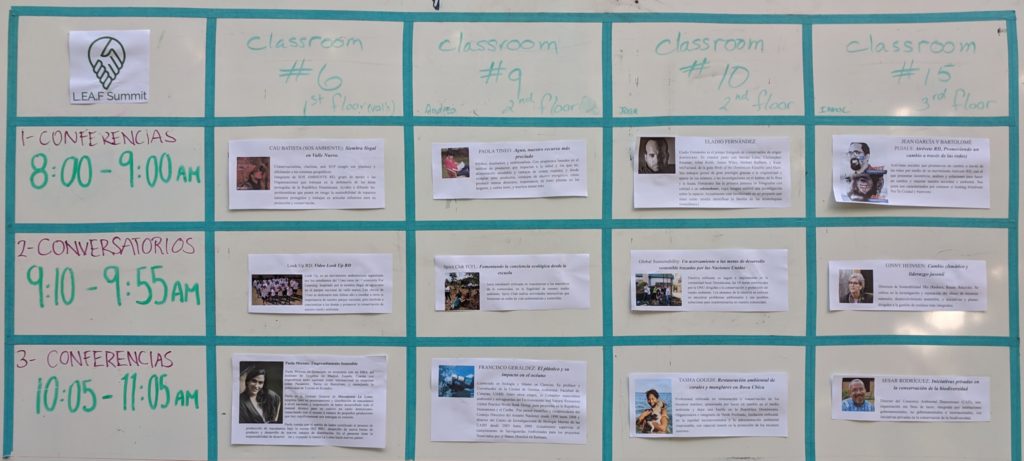
The idea for LEAF first began back in February, when our 11th grade students put together a video about the misuse of protected lands in the Dominican Republic for our yearly Independence Day program. Following that, they created an Instagram account called @lookup_RD where they posted information about the environmental issues we face in the Dominican Republic. Several prominent Dominican environmentalists began to follow them, making them feel more enthusiastic about their project. Next, the students came up with the idea of holding an environmental conference and asked the school for permission. We said, “Go for it!” Several of them took the lead, contacting speakers, designing posters, writing up informational bios, creating a logo, and delegating all the small tasks they needed to do
These 11th grade students did an incredible amount of research and learning on this journey. None of it was for a grade, a teacher, or a class — they did it over and above all the other work they had to do, and they did it with enthusiasm. We never heard them complain about feeling overwhelmed or stressed, and this positive attitude carried over to all their other classes. I wanted to find out how this happened and what the school could learn from this initiative.
5 Big Take-Aways
Allow Students to Solve Real-Life Problems
This learning opportunity was an incredible motivator for learning, since it was born of a very large, real-life problem that our students felt passionate about. But along the way they also bumped up against a number of smaller problems that they had to solve. One of the problems our students faced was a design issue, which they spoke to me about post-conference when I asked them a few questions about their process:
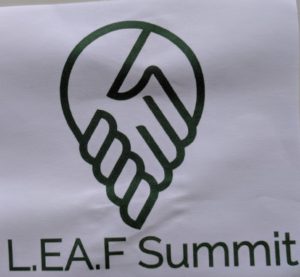
Student-created LEAF logo
“Finding an acronym for the conference was harder than we thought. We liked the letters in LEAF but couldn’t make it work. We wanted the acronym to be short and catchy, but it also had to be meaningful. We came up with the ‘environmental awareness fair’ but we had to think of what the L could stand for. We finally went with ‘local’ because when people see environmental issues as ‘global,’ the problem seems too huge and they don’t know where to start. But when you put it in the perspective of ‘local,’ it helps spark the idea that ‘my contribution does count.’ Local gives us the push to do something.”
It was harder than students expected to create an acronym, but after struggling with the problem and solving it, they felt proud of their final product and ready to take on other issues.
They also faced the problem of having speakers cancel at the last minute. At times there was a real risk that the conference wouldn’t happen, and these were moments when it became tempting for teachers to jump in and help. But when this happens, it’s important to stand back and let students struggle, even if there’s a risk of failure. The 21st century skills involve critical thinking and problem-solving, and in order to master these, students need to grapple with problems and learn to solve them.
Make Learning Relevant
I asked the students why they were willing to put so much effort into this project, even though they weren’t getting a grade for it (and they were still having to complete other assignments). Their answer gave me goosebumps:
“When you’re aware of a problem, and you have the opportunity and the tools to do something about it, it would be selfish not to. It’s not that we do everything for grades. If we have a passion, we want to do it. Actually, when you do it for a grade, it has the opposite effect. You care about the grade, not the learning, and you feel less motivated.”
When we mention “relevance” in education, we often talk about the importance of showing students the why behind what they’re learning. But relevance goes deeper than this. Although it’s true that they should know why they need to learn how to write an essay, the learning is much more meaningful when their essay is about an issue that inspires them.
Give Up Control
This is a hard one for many of us. Our students are working so hard… what if they don’t succeed? Although we may want to ensure a perfect outcome for them, we have to remember that “messing up” is an important part of learning.
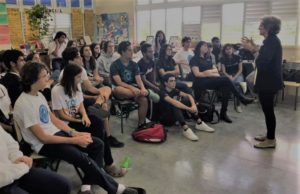
Environmentalist Ginny Heinsen speaks about climate change and student leadership
“We were surprised when the school let us take this on. All the phone calls and all the WhatsApp conversations with the environmentalists made us feel like adults, like we were in charge. That’s a great feeling.”
The words “we felt like adults” are crucial. When we trust students to do the work, when we allow them to take the reins, they feel empowered and they will do so much more than we expect.
Present to an Authentic Audience
When doing projects, it’s motivating for students to know that their work will be seen beyond the school:
“It seemed surreal when this actually happened, because I didn’t think these environmentalists would respond to us. We’re just a bunch of students. It was empowering to realize that we can do this!”
The environmentalists who came to visit also mentioned how impressed they were with this student initiative. The feedback I repeatedly heard was that these students were incredibly responsible, “Carla, these students were on top of things. They communicated regularly with me, sending reminders and follow-ups. Their emails were so professional: well-written and concise. They kept the ball rolling.”
Having teachers and students come in from other schools added another level of authenticity. The 11th graders knew that if things went wrong, peers from their own school would be forgiving, but they really didn’t want to look bad in front of teachers and students they didn’t know.
Provide Voice and Choice
We know that providing voice and choice is crucial to learning, but hearing it directly from our students is a powerful reminder.
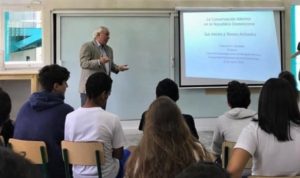
Francisco Geraldez speaking about the impact of plastics on the ocean.
“Since we weren’t doing this for a grade, but on our own initiative, it was easier to remain positive. If someone forces you to do something, you get fed up. But when it’s your own choice, you care. You want to do the work. In the last week, we were under a lot of pressure to get everything done and we were stressed, but it didn’t matter.”
We know this. We know how important it is for students to choose their learning and run with it. But how much real choice do we give them day to day?
Using these lessons going forward:
This project felt real to the students because it was their baby. We know kids do better when they’re engaged and motivated, so how do we tie more projects like this to our curriculum?
- Involve students in finding solutions to problems the school faces. For instance, last year, we asked our students to help us go green by finding us a source of affordable alternative energy.
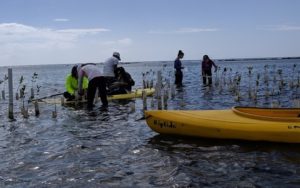
- Work to solve local issues. Our Spirit Club works most weekends to help a beach community restore mangrove and coral reef growth.
- Have students come up with questions they care about in class. This post by Bianca Hewes will give you great ideas! (And while you’re there, be sure to check out her other articles. I put “project” in the search box, and got so much info.)
Next year, we’ll be putting an even stronger focus on helping our students discover their interests and create projects they feel passionate about. The question we will be grappling with is: how do we make this happen on a larger scale for all our students? I’d love to hear your ideas and suggestions.

Carla, what a wonderful experience to be able to write about and be a part of-I am envious! It’s the dream of most educators to be able to show students that they can change the world. I look forward to exploring the Site you linked near the end and seeing what the students do next year!
I agree – these kids are truly amazing, Ambre. I’m also excited to see how far they’ll take this project next year. The best learning happens when they take the reigns and begin to teach us!
It is because of the leadership that this is all happening. Your article is a model for all. This is to be shared with the world. Love to talk to you about USQ20, a learning experience where teachers and students are design partners in teaching and learning. Your students would be amazing facilitators at the conference.
Dale, I’d love to know more about USQ20. Can we talk? This group of students is working with their teachers to design their 12th grade learning and projects. We’re open to any advice you can give!